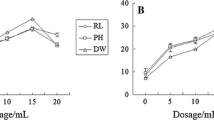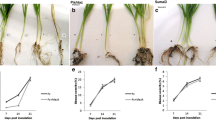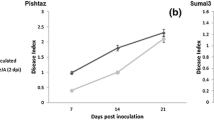Abstract
Allelopathic activity of rice extracts and root exudates against Echinochloa crus-galli increased by heavy metal, cantharidin and jasmonic acid treatments. Since cantharidin (protein phosphatase inhibitor) acts as an elicitor and jasmonic acid is an important signaling molecule regulating inducible defense genes against the pathogen infection, heavy metal stress and pathogen infection may increase alleopathic activity of rice. These treatments also increased the concentrations of momilactone B in rice extracts and root exudates, suggesting that the production of momilactone B in rice and the secretion of momilactone B from rice into the rhizosphere may be enhanced by the treatments. As momilactone B possesses strong phytotoxic and allelopathic activities, the elevated production and secretion of momilactone B of rice by heavy metals, cantharidin and jasmonic acid may contribute to the increasing allelopathic activity of rice. Enhancement of the secretion of momilactone B into the rhizosphere may provide a competitive advantage for root establishment through local suppression of pathogen and inhibition of the growth of competing plant species. Therefore, allelopathy of rice may be one of the inducible defense mechanisms and may be regulated several environmental factors.





Similar content being viewed by others
References
Bais HP, Park S-W, Weir TL, Callaway RM, Vivanco JM (2004) How plants communicate using the underground information superhighway. Trends Plant Sci 9:26–32
Belz RG (2007) Allelopathy in crop/weed interactions—an update. Pest Manag Sci 63:308–326
Bi HH, Zeng RS, Su LM, An M, Luo SM (2007) Rice allelopathy induced by methyl jasmonate and methyl salicylate. J Chem Ecol 33:1089–1103
Dilday RH, Yan WG, Moldenhauer KAK, Gravois KA (1998) Allelopathic activity in rice for controlling major aquatic weeds. In: Olofsdotter M (ed) Allelopathy in rice. International Rice Research Institute, Manila, pp 7–26
Einhellig FA (1999) An integrated view of allelochemicals amid multiple stresses. In: Inderjit DKMM, Foy CL (eds) Principals and practices in plant ecology: allelochemical interactions. CRC Press, Boca Raton, pp 479–494
Glazebrook J (2005) Contrasting mechanisms of defense against biotrophic and necrotrophic pathogens. Annu Rev Phytopathol 43:205–227
Halim VA, Vess A, Scheel D, Rosahl S (2006) The role of salicylic acid and jasmonic acid in pathogen defence. Plant Biol 8:307–313
Hawes MC, Gunawardena U, Miyasaka S, Zhao X (2000) The role of root border cells in plant defense. Trends Plant Sci 5:128–133
He H, Shen L, Xiong J, Jia X, Lin WX, Wu H (2004) Conditional genetic effect of allelopathy in rice (Oryza sativa L.) under different environmental conditions. Plant Growth Regul 44:211–218
Jung Y-H, Lee J-H, Agrawal GK, Rakwal R, Kim J-A, Shim J-K, Lee S-K, Jeon J-S, Koh H-J, Lee Y-H, Iwahashi H, Jwa N-S (2005) The rice (Oryza sativa) blast lesion mimic mutant, blm, may confer resistance to blast pathogens by triggering multiple defense-associated signaling pathways. Plant Physiol Biochem 43:397–406
Kato-Noguchi H, Ino T, Sata N, Yamamura S (2002) Isolation and identification of a potent allelopathic substance in rice root exudates. Physiol Plant 115:401–405
Kato-Noguchi H, Ino T, Ichii M (2003) Changes in release level of momilactone B into the environment from rice throughout its life cycle. Funct Plant Biol 30:995–997
Kato-Noguchi H, Ota K, Ino T (2008) Release of momilactone A and B from rice plants into the rhizosphere and its bioactivities. Allelopathy J 22:321–328
Kim KU, Shin DH, Kim HY, Lee ZL, Olofsdotter M (1999) Evaluation of allelopathic potential in rice germplasm. Korean J Weed Sci 19:1–9
Kim KU, Shin DH, Lee IJ, Kim HY (2000) Rice allelopathy in Korea. In: Kim KU, Shin DH (eds) Rice allelopathy. Kyungpook National University, Taegu, pp 57–82
Kodama O, Yamada H, Yamamoto A, Takemoto T, Akatsuka T (1988) Induction of phytoalexins with heavy metal ions in rice leaves. J Pestic Sci 13:615–617
Kume T, Nagasawa N, Yoshii F (2002) Utilization of carbohydrates by radiation processing. Radiat Phys Chem 63:625–627
MacKintosh C, Lyon GD, MacKintosh RW (1994) Protein phosphatase inhibitors activate anti-fungal defence responses of soybean cotyledons and cell cultures. Plant J 5:137–147
McCully E (1999) Roots in soil: unearthing the complexities of roots and their rhizospheres. Annu Rev Plant Physiol Plant Mol Biol 50:695–718
Okada A, Shimizu T, Okada K, Kuzuyama T, Koga J, Shibuya N, Nojiri H, Yamane H (2007) Elicitor induced activation of the methylerythritol phosphate pathway toward phytoalexins biosynthesis in rice. Plant Mol Biol 65:177–187
Olofsdotter M, Navarez D, Rebulanan M, Streibig JC (1999) Weed-suppressing rice cultivars: does allelopathy play a role? Weed Res 39:441–454
Otomo K, Kenmoku H, Oikawa H, König WA, Toshima H, Mitsuhashi W, Yamane H, Sassa T, Toyomasu T (2004) Biological functions of ent- and syn-copalyl diphosphate synthases in rice: key enzymes for the branch point of gibberellin and phytoalexin biosynthesis. Plant J 39:886–893
Peña-Cortés H, Barrios P, Dorta F, Polanco V, Sánchez C, Sánchez E, Ramírez I (2005) Involvement of jasmonic acid and derivatives in plant response to pathogens and insects and in fruit ripening. J Plant Growth Regul 23:246–260
Rakwal R, Shii K, Agrawaland GK, Yonekura M (2001) Protein phosphatase inhibitors activate defense responses in rice (Oryza sativa) leaves. Physiol Plant 111:151–157
Shen L, Lin W (2007) Effects of phosphorus levels on allelopathic potential of rice co-cultured with barnyardgrass. Allelopathy J 19:393–402
Song B, Xiong J, Fang C, Qiu L, Lin R, Liang Y, Lin W (2008) Allelopathic enhancement and differential gene expression in rice under low nitrogen treatment. J Chem Ecol 34:688–695
Thoma I, Krischke M, Loeffler C, Mueller MJ (2004) The isoprostanoid pathway in plants. Chem Phys Lipids 128:135–148
Wu H, Pratley J, Lemerle D, Haig T (1999) Crop cultivars with allelopathic capability. Weed Res 39:171–180
Author information
Authors and Affiliations
Corresponding author
Rights and permissions
About this article
Cite this article
Kato-Noguchi, H. Stress-induced allelopathic activity and momilactone B in rice. Plant Growth Regul 59, 153–158 (2009). https://doi.org/10.1007/s10725-009-9398-4
Received:
Accepted:
Published:
Issue Date:
DOI: https://doi.org/10.1007/s10725-009-9398-4




